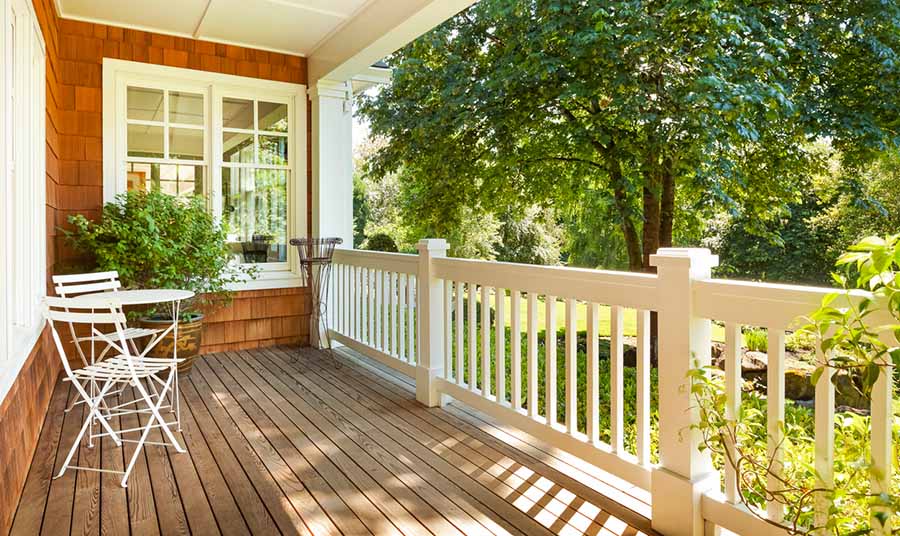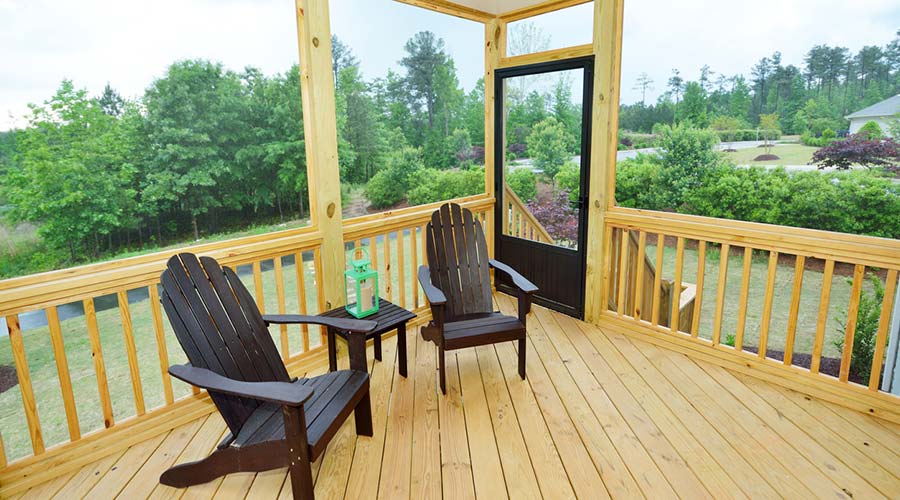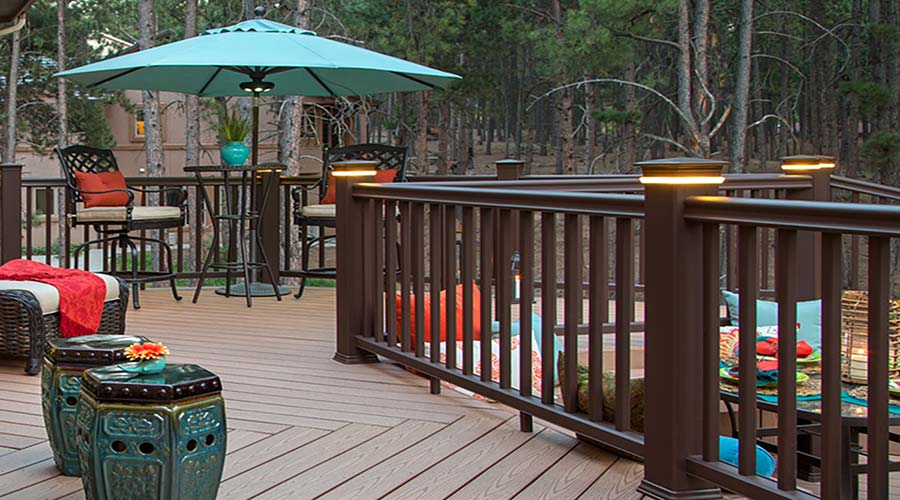


People fall off raised unguarded platforms all the time; children, the old, people afraid of heights, and even those not paying attention to their surroundings. It could be a minor or a significant fall, but a fall. That’s why people need a handrail to hold onto.
Any porch or deck 30 inches above grade should have a railing guard at least 36 inches high from the platform surface. Hand railings protect people against accidental falls. Even if your porch is less than 30 inches above grade, installing a railing for additional safety may be worthwhile.
The average height of a person is 5½ feet, which is 66 inches, which means that the handrail falls around the abdomen of the average person allowing them to lean on the rail and not topple over.
Porch railings are mainly installed to give your porch a fine finish in terms of design and glamour, but above all else, porch railings are needed for safety purposes.
Do you need to have railings on your porch?
Does the landing of your porch stand 30 inches above grade? The grade is the construction term that means ground. The height of your porch or deck determines whether you need railings or not.
In many instances, platforms that exceed 16 to 24 inches tall should have a railing, although local building codes don’t require one.
In general, and at the end of the day, the safety of every individual in your household takes precedence. The following questions will help you determine how many inches above grade needs a railing against accidental fall:
Deck railings are about the height of the railing, the spacing posts, and the vertical or horizontal space of the balusters.
The spacing on the balusters has a recommendation of 4 inches in width, which is enough to limit objects or bodies bigger than that to pass through it. The 4-inch spacing is enough to deter young children and pets from going through it in the practical world.
The standard 36-inch height (minimum 34-inches height requirement) is recommended in residential homes and 42 inches on commercial buildings, which is comfortable for most people to use without toppling over.
Two organizations regulate and decide on the regulations and designs for buildings and their accessories, whether commercial or residential. These are the International Residential and Building Codes.
The railing posts are the most critical parts of the entire railing system. That is because the posts translate to the strength of the railing system.
There are two primary specifications for deck railing posts:
No construction stands firm without pillars. The posts are the pillars that shoot straight from below grade to 66 inches above.
The building code dictates the recommended height of all raised platforms, including decks and porches. In their recommendations, any platform that stands 30 inches above grade should have a railing.
They further recommend that from the base of the landing, the minimum height should not drop below the size of 34 inches, but 36 inches would be more suitable.
That makes the posts that shoot below more than 66 inches in height which translates to 5½ feet tall.
The strength and stability of the deck and railing depend on the posts. Posts should be no more than 6 or 8 feet apart.
There are two sizes of railing posts commonly used: 4×4 and 6×6.
Now, if you are using the 4×4 posts that are smaller in size, the spacing between rails should be a maximum of 6 feet, and for those that use 6×6 posts, spacing should be 8 feet apart.
This calculated measurement will help the railing be strong as it distributes weight across the divide.

The first step to installing a railing on your deck or porch is determining the space between the posts. The spaces between the railing will dictate the spacing of the pickets or balusters you will install.
In other words, it ensures the structural integrity of the railing.
If you want to void costly reinstallations later in your remodeling project, it’s ideal for calculating the post spacing before installing your railing.
Here are the steps to calculating your post spacing.
The first step is to measure the distance between the corner posts of your deck with a measuring tape. If you plan on installing railing on both sides of the decks, don’t forget to measure the length of each section.
Split the length of the railing to come up with sections of equal lengths between five and seven feet.
Sometimes it can be challenging to divide the length of your deck. An online spacing calculator can be helpful in this venture. It allows you to calculate the spacing of your posts using the width of the posts, the length of the area to rail, and the size of the balustrades.
Mark the placement of the posts on the deck. Center a post on each of these marks, and mark the deck on each side of the post.
Drill two 1/4inch holes through the base of each of your posts using a drill, then attach the posts to the deck with bolts or screws using a screwdriver.

A porch railing has several advantages for the household, which will help you decide if your porch needs it or not:
It is no secret that the porch welcomes people into your home. Today, many homes do not concentrate so much on the front and the back. The backyard runs the show as far as entertainment and comfort are concerned.
But the front porch has never lost its taste and glory. It’s the difference that a warm, inviting home holds over the rest.
It gives your home the illusion of hugeness, just like wall mirrors do to a room while giving it the embodiment of trust and safety.
Will potential buyers be attracted to a home with a front porch guarded with rails? Most definitely, yes.
Most homes whose porches have a handrail have their stairs guarded as well. The availability of something to hold onto as you climb up or down the stairs at home is very comforting and assuring.
Imagine coming home from work tired and feeling frail, and you have to climb stairs that do not have support.
Handrails provide support and guidance when feeling tired, sickly, and your sight is wanting. It’s like an old friend whose hand you can always trust to hold in times of turbulence and uncertainty.
Safety is the main reason that porch railings are required in the first place. People fall off platforms all the time; bruises and injuries from falls differ, but why risk them when you can prevent them?
The front porch is a place to breathe in the fresh air and bask in the sun while relaxing alone or with family. You can predict where accidental falls are likely to happen, and handrails are there to provide safety for when:
The residential building code requires a railing for steps over 30 inches above grade (or 2.5 feet). Therefore the maximum height you can build a deck and not have a railing is 29 inches or less. Local codes may vary, so check with your city or county building department to confirm.
Deck railing height codes vary by location. A 42-inch railing is needed on a commercial building, most second-floor balconies, or if your deck has built-in bench seating. For a deck with bench seating that is 16 inches above the deck surface, the deck railing has to be 36 inches or 42 inches above the bench seat.
Any platform 30 inches above grade should have a railing guard at least 36 inches above the deck surface.
The organizations that regulate and dictate the residential building code requirements might have universal rules that run across the country and beyond the borders. Still, every state has slight variations of the same.
If you happen to shift residence from one state to another, you might want to check with the area codes on what is expected of you before embarking on a building project.
This is to avoid getting into unnecessary trouble with authorities when the time for home inspection arrives. You run into the unfortunate troublesome possibility of demolishing what you have to replace with railings bearing required heights and measurements.